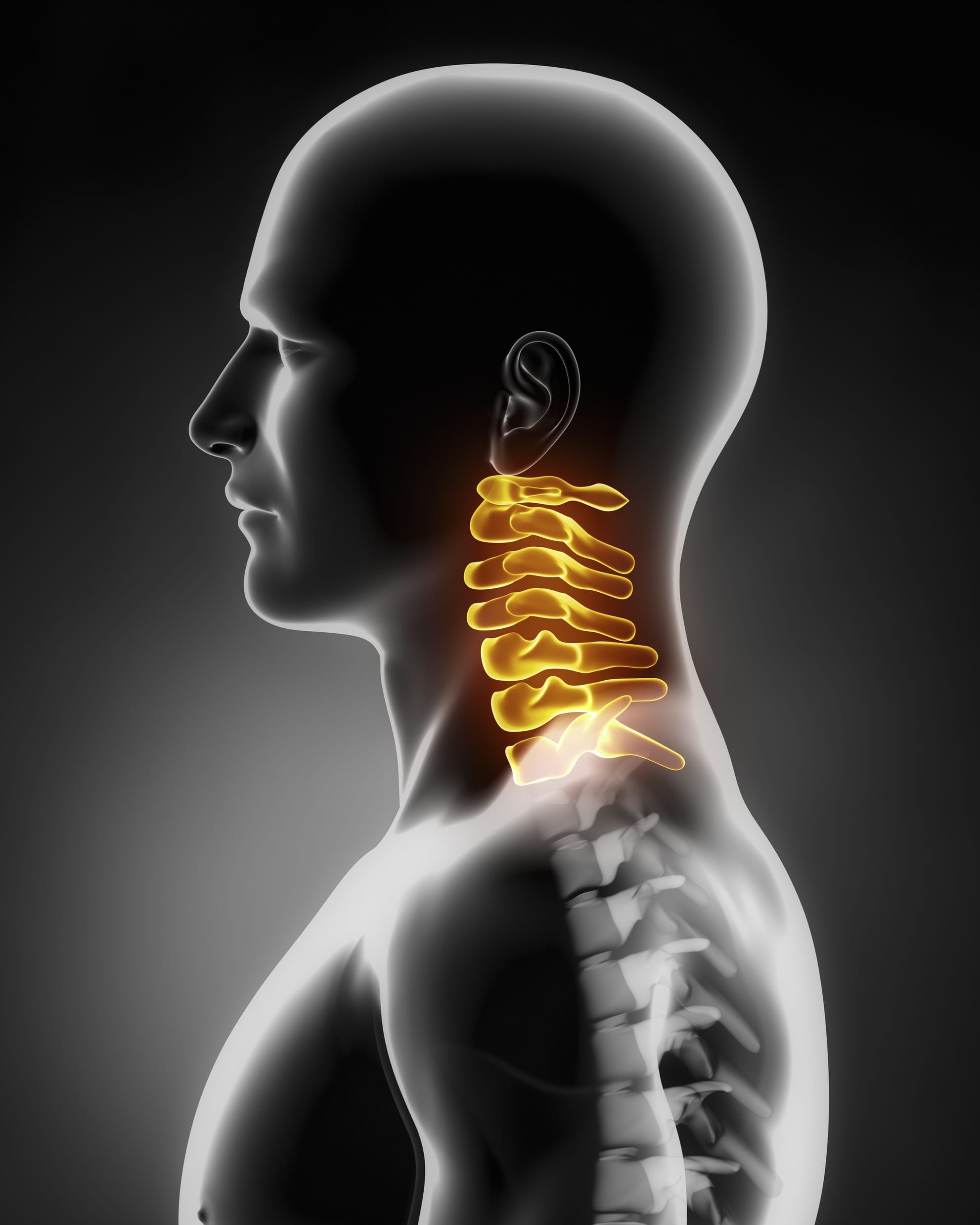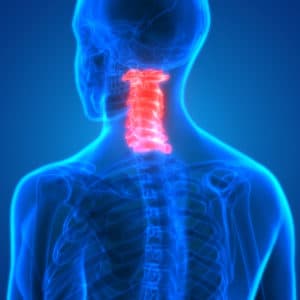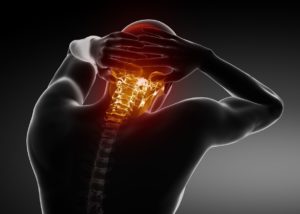What Is The Cervical Spine?
The cervical spine is one of the most important and agile parts of your body, as it is the neck region of your body. The region begins at the base of the skull and consists of 7 bones separated by intervertebral discs that allow the spine to move freely. The neck has the greatest amount of movement of any area of the spine and is also responsible for protecting the spinal cord and supporting the skull. Because of its vital function in our everyday lives, injury or disease of the cervical spine is a very serious condition.

What Causes Cervical Spine Pain?
The cervical spine consists of seven vertebrae:
- C1-C7
- Joints
- Muscles
- Ligaments
- Tendons.
They are most commonly known as your neck. Your neck has an amazing range of motion and it holds up your head, which weighs around 11 pounds. All of these parts wear down and can become injured. When an injury involves a muscle or ligament, the pain is usually acute and heals relatively quickly. Neck pain that lasts at least three months is considered to be chronic pain, and that’s where cervical disc problems and issues with the vertebrae are usually involved.
The discs provide spacing and cushion between the cervical vertebrae. When they degenerate or herniate, neck pain that can radiate into the shoulders, arms, and hands often follows. The facet joints of the vertebrae restrict the range of motion in the spine, but also allow movement. If the protective cartilage on the facet joints wears down or tears, the joint deteriorates and the body grows bone spurs to stabilize the joint. These spurs will often press on exiting nerves, known as compression. This will lead to chronic pain in the form of tingling, numbness, and/or weakness radiating down the arm served by the nerve. Degeneration of the discs and facet joints can also cause the spinal cord to become compressed, another source of chronic pain.
Dr. Todd Albert performs various surgeries in New York City to remedy the issues with the cervical discs and the cervical spine.
How Are Cervical Spine Problems Diagnosed?
When a patient comes to Dr. Albert complaining of chronic neck pain, he starts his diagnosis by going through your medical history. He will want to know when your symptoms started, if they worsen in response to some activity, and what you’ve done thus far to try and alleviate the pain. He will then perform a physical exam where he checks for tenderness, numbness, and muscle weakness. He will also test your range of motion is, moving your head forward, backward, and from side to side.
From there, if he needs to get a better picture of what’s going on with your cervical vertebrae and your discs, he will likely move to imaging tests:
X-Rays
X-rays can show bone spurs and areas of your neck where your nerves might be pinched.
CT Scans
These scans combine x-ray images takes from many different directions to produce detailed cross-sectional views of the internal bony anatomy of your neck.
MRIs
Using radio waves and magnetic fields, MRIs create detailed images of both the bones and the soft tissue, including your spinal cord and the nerve roots.
Electromyography
Electromyography tests the speed of your nerve conduction to see if nerve compression is hindering function. Dr. Albert inserts fine needles into a muscle to conduct these measurements.
Blood Tests
Blood tests may be used to rule out infectious conditions or inflammation due to other causes.
What Our Patients Have To Say
"Amazing DR and staff -highly recommend he did my back few years and now I can walk a lot better"
"Dr. Albert is the best. I couldn’t not ask for a better doctor and I think it would be hard to find one.I had cervical decompression 5 years ago and I’m doing great. I’m back to doing everything I did before the surgery!"
What Are The Symptoms Of Cervical Spine Problems?
Neck pain is highly varied. It can be something as innocent as a stiff neck or it can be continual and debilitating. Most of the causes of acute pain come from the muscles, tendons, or ligaments that help support the neck and shoulders. Chronic pain usually involves the discs, nerves, vertebrae, or the spinal cord as it runs through the cervical spine.
These are common neck pain symptoms:
- Stiff neck — Usually acute, this pain comes when the person turns the neck from side to side.
- Sharp pain — This may be stabbing or stinging pain and usually occurs in the lower levels of the cervical spine.
- General soreness — This can be residual pain from a neck movement that was out of the normal range of motion, such as whiplash.
- Radiating pain — This pain can feel like burning or searing. It originates in the neck area but follows the path of the affected nerve down into the shoulders and arms.
- Tingling, numbness, or weakness — These types of radiating pain usually feel like pins and needles in the arms and down into the fingers.
- Trouble with grasping or lifting — If there is numbness, tingling, or weakness this can lead to loss of muscle strength.
- Headaches — A pinched occipital nerve can cause a headache in the sides of the head of the scalp. Also, tight neck muscles can lead to tension headaches.
Cervical Spine Surgery In NYC By Dr. Todd Albert
Top Spine Surgeon, Dr. Todd Albert, specializes in cervical spine surgery. The most common surgeries he performs to treat cervical spine conditions include:
- Anterior Cervical Decompression and Fusion Surgery (ACDF)
- Cervical Disc Arthroplasty (CDR)
- Laminoplasty
Anterior Cervical Decompression And Fusion Surgery (ACDF)
Anterior cervical decompression and fusion surgery (ACDF) consists of two major parts. The bony portion & the instrumentation. Typically, Dr. Albert does not need to take a bone graft from the hip area, meaning a separate incision is not necessary.
Cervical Disc Arthroplasty (CDR)
When a disc in your neck herniates, the material can place pressure on your nerves in that area. Dr. Albert removes the herniated disc and replaces it with an artificial disc, thus eliminating the pain and returning function. This is known as cervical disc arthroplasty.
Laminoplasty
The Laminoplasty procedure helps relieve nerve pressure and pain that is caused by spinal stenosis. This can be performed on any of the 3 regions of the spine.
Am I A Candidate For Cervical Spine Surgery In NYC?
Conservative treatments for neck pain begin with rest and icing. Next could be massage and posture changes. When a doctor gets involved, he or she will probably add physical therapy, prescription pain medication, and maybe cervical epidural steroid injections.

If these conservative treatments don’t alleviate your neck pain, it is then likely a result of degenerated cervical discs, nerve compression, or spinal cord compression in the cervical spine. If you are experiencing these types of pain, it may be time to call Dr. Albert and utilize his expertise in spinal surgery.
Cervical neck surgery may be necessary:
- To remove a damaged disc or bone spurs that are pressing on and irritating a nerve root.
- To stabilize the cervical spine
- To decompress the spinal cord
What Are The Benefits Of Cervical Spine Surgery?
Undergoing cervical spine surgery in NYC can be beneficial for patients whose daily life is affected by pain. Neck procedures have a high success rate when the cause of pain is accurately identified. Studies indicate that surgery to reduce pressure on a trapped cervical nerve can reduce hand and arm pain as well as localized pain in the neck.
Can People Of Any Age Get Cervical Spine Surgery?
There are no age requirements for cervical spine surgery, but the patient needs to be healthy enough for surgery. The condition of the potential patient’s heart, lungs, and other major organs would be the only impediment to surgery to address chronic pain originating in the cervical spine.
What Should I Expect During My Cervical Spine Surgery Consultation?
With all consultations, we seek to create a two-way flow of information between the patient and Dr. Albert. We encourage you to come prepared with questions and concerns that you may have. If surgery is indicated, Dr. Albert will explain the surgery he intends to perform. Dr. Albert and his team will provide details of what you can expect in before, during and after the procedure as well as a discussion regarding potential risks and complications of the recommended surgery.
When your consultation is complete, you should have a thorough understanding of what your surgery will entail and what it should achieve.
How Long Does A Cervical Spine Surgery Take?
Because there are different surgeries depending upon the patient’s situation, everything from cervical fusion to laminoplasty or artificial disc replacement. We can provide a general guide as to the length of the recommended procedure. During your consultation with Dr. Albert, he will give you an idea of how long your procedure will take.
Should I Try Physical Therapy Before Having Cervical Spine Surgery?
Except in cases of trauma, surgery is rarely the first course of treatment. Dr. Albert believes in exhausting all conservative measures before recommending that a patient proceed with cervical spine surgery.
When a person has chronic neck pain, he or she oftentimes avoids moving their neck. Over time, this causes the muscles in the neck, shoulders, and back to weaken or atrophy. Some patients also experience muscle tightness in their neck as a primary symptom. The combination of weakness and tightness only exacerbates the patient’s pain. A physical therapist can design a physical therapy program to target these areas and help to recondition the muscles of the cervical spine.
Can A Chiropractor Help With Cervical Spine Problems?
In cases of disc herniation, studies have shown that chiropractic manipulation of the cervical spine, especially the high velocity thrust technique, can actually worsen the patient’s pain. Risks with these chiropractic adjustments include marked increase in pain, numbness, weakness, worsening myelopathy, and even a possible stroke (vertebral artery dissection).
What Is Cervical Myelopathy?
Myelopathy is a condition that results from compression of the spinal cord. Cervical myelopathy is a condition that develops when there is spinal cord compression in the cervical spine (neck).
How Can Having Cervical Spine Surgery In NYC Help Cervical Myelopathy?
Nonsurgical modalities are often recommended to reduce the severity of symptoms related to cervical myelopathy. Surgery is the only way to alleviate the pressure on the spinal cord. While most patients notice an improvement in their symptoms, the main goal of surgery that is performed for a diagnosis of cervical myelopathy is to prevent the progression of symptoms.
What Is Cervical Radiculopathy?
Cervical radiculopathy is the condition in which nerve function is disturbed or damaged by compression on a nerve root. When a nerve root is compressed or damaged, sensations along the nerve pathway are altered. This may result in pain, tingling, or a loss of sensation and strength. Cervical radiculopathy may affect the arm and hand.
How Can Cervical Spine Surgery Help Cervical Radiculopathy?
Surgical treatment for cervical radiculopathy revolves around relieving pressure on the nerve root. This may be achieved by removing pieces of soft tissue such as a bulging disc or shaving off small amounts of bone.
What Is Cervical Foraminal Stenosis?
Stenosis is a term used to describe an abnormal narrowing of a structure. Cervical foraminal stenosis is a condition in which the bony tunnel through which the nerves stemming from the spinal cord travel, are narrowed. This narrowing results in compression on the nerve or nerves. Cervical foraminal stenosis can cause pain in the shoulder, arm, or hand.
How Can Cervical Spine Surgery Help Cervical Foraminal Stenosis?
Surgery may be advisable if conservative treatments do not relieve the symptoms of cervical foraminal stenosis. Several surgical techniques may be considered. Dr. Albert selects the best technique based on the cause and location of the stenosis. For example, if the cause of stenosis is a herniated disc, that disc will be repaired or removed as needed to improve nerve function. In some cases, a foraminotomy is performed. This procedure expands the passageway that has narrowed by removing obstructions such as bone spurs.
What Is The Ossification Of The Posterior Longitudinal Ligament?
Ossification of the posterior longitudinal ligament (OPLL) occurs when the flexible ligament that stabilizes the bones of the spine becomes thick and inflexible. This ligament travels from the 2nd vertebra in the neck to the end of the spine near the pelvis. It runs alongside the spinal cord. Ossification of the posterior longitudinal ligament may develop in the cervical spine.

How Can Cervical Spine Surgery Help Ossification Of The Posterior Longitudinal Ligament?
There are several cervical procedures that may be performed to reduce the symptoms of ossification of the posterior longitudinal ligament. The most appropriate surgery is selected based on factors such as the number of spinal segments involved and the degree of spinal deformity.
How To Prevent Cervical Spinal Problems?
There are thousands of different exercises that target the neck, shoulders, and the cervical spine. These are just a few examples:
- Shrugs — Stand looking forward with your hands holding weights at your sides. Then, move your shoulders up towards your ears keeping your hands at your sides. Finally, move your shoulders back as if you are trying to touch your shoulder blades together and rotate them.
- Neck extensions — Lie face down on a bed or bench with your head hanging over the edge. Then start to raise your head, as if you’re trying to look upwards. Continue until your chin is parallel to the floor.
- Neck rotations — From the same position lying face down on the bed with your head hanging over the edge, rotate your chin towards either shoulder. Repeat it to the other side. You can combine this with the neck extension.
- Lateral stretching — Standing or sitting straight up, take one hand and place it on top of your head. Slowly pull your head down, moving that ear down towards your shoulder. Pull until you feel a stretch on the opposite side of your neck.
Can I Treat My Neck Pain Effectively At Home?
As mentioned above, the last resort for most cases of neck or arm pain is surgery. Surgery may become necessary if a patient is losing feeling in their arms, hands, or fingers, as nerve compression can lead to nerve damage. It can also be an immediate concern in cases of neck trauma, such as during a car accident.
Otherwise, conservative treatments always come first. There are things you can do at home to alleviate your neck pain. Here are five at-home strategies for relieving the pain caused by your cervical spine.
- Rest — Find a comfortable position that does not cause any neck pain and allows you to rest your head on a pillow or chair. If it helps, you can also roll up a towel and place it under your neck to keep it in a neutral position.
- Ice or heat — You can apply ice or heat, whichever feels best. This isn’t the same as when you have an injury and ice for the first day or two to reduce swelling. You should apply the ice or heat for 20 minutes and then leave it off for at least the next 40 minutes.
- Stretching — Exercises that stretch your neck muscles can be quite effective for relieving pain and for increasing flexibility. With these exercises you’ll turn your head to each side and hold it for 20 seconds; you’ll tilt your head to each side and use the hand on that side to stretch it a little extra; you’ll bend your head forward and try to touch your chest; you’ll look straight up into the sky and hold the position; and other exercises.
- Exercise — Exercise has been proven to be effective for neck pain, as well as your overall health, of course. Strength, endurance, and aerobic exercise helps to keep your neck and back muscles strong, and it improves blood flow, which can help to nourish your spine and the surrounding muscles.
- Posture — Something as simple as sitting up straight at work and making sure your chair is aligned right up against your entire back can help. Your computer should be about eye level, and your neck should be straight, rather than hunched forward toward your screen.
What Happens If I Leave My Chronic Neck Untreated?
When a patient has chronic neck or pain that is radiating out into the shoulders, arms and hands, this is usually due to degenerative changes or compression of the spinal cord or of nerve roots exiting the spinal canal in the cervical spine. When the pain has been chronic and ongoing, this likely means the situation wasn’t a one-time strain or other injury that can improve. The chronic nature indicates that the nerve compression is not going to improve on its own.
The impact of leaving these problems untreated is subjective, however it can be substantial. It can make your life more difficult, as you’ll be dealing with ongoing pain. You may even avoid doing many of the things you used to find enjoyable secondary to the pain. Additionally, nerve compression can lead permanent nerve injury if left untreated. If this happens you could be at risk of losing function in the muscles served by the compressed nerve.
When Should I See A Doctor For Neck Pain?
It can be difficult to know whether neck pain merits contacting a doctor. You may have slept with your head in an odd position and you’ve awakened with a stiff neck. While it may be very painful, it’s probably not something your doctor can do anything about. And it will probably be gone by nighttime or the next day.

However, if your neck pain has endured and is impacting your daily life, then it’s time to see a doctor.
This is particularly the case when the pain has taken on the form of tingling, numbness, or weakness in your fingers, hands, or arms. This can be a sign that a nerve is being compressed to the point that it is beginning to be damaged. If this type of compression is allowed to continue, it can lead to permanent nerve damage, which will then affect muscle movement and strength.
How Long Does It Take To Recover From Cervical Spine Surgery?
Recovery is a process that differs from one person to another. Generally, the majority of healing occurs within the first 4 to 6 weeks after surgery. Recovery is dependent on factors such as the general health of the patient, adherence to post-op care guidelines, and the type of surgery that was performed. During your consultation, Dr. Albert will do his best to provide you with an estimate of your recovery time and what you might expect after surgery.
How Long After Cervical Spine Surgery Can I Return To Normal Activities?
Following their cervical spine surgery in NYC, patients can expect to:
- Return to work in about 3 to 4 weeks.
- Drive within about 3 to 6 weeks, providing that they can turn their head and are no longer taking prescription medications that could impair their driving.
- Regain the ability to lift moderately heavy objects in about 4 to 6 weeks.
- Resume normal bending and twisting movements gradually over several weeks after surgery.
- Resume low impact sports in 6 to 8 months.
What Are The Risks Involved With Cervical Spine Surgery?
As with any surgery, there are risks involved such as a reaction to anesthesia, possible infection and delayed healing. Possible complications specific to cervical spine surgery include injury to the spinal cord, nerves, esophagus, carotid artery, or vocal cords; non-healing of the bony fusion; failure to improve; failure of the instrumentation (with fusion); and infection.
Schedule A Consultation With Our Neck Specialist In NYC, Dr. Albert
If you are experiencing neck pain, call 212-606-1004 to schedule a consultation with New York Spine Surgeon, Dr. Todd Albert.


